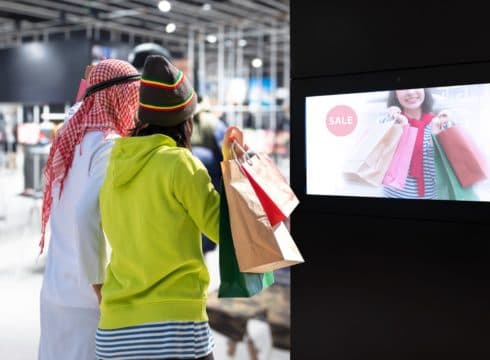AI and ML have changed the way both offline and e-retailers interact with or approach the customer
It is also being widely used to predict a products “shelf-life” online
AI and ML have helped to bring 20% of sales growth in Indian fashion e-retailing space alone
Inc42 Daily Brief
Stay Ahead With Daily News & Analysis on India’s Tech & Startup Economy
Artificial Intelligence (AI) and Machine Learning (ML) technologies have changed the way both offline and e-retailers interact with or approach the customer and the way they offer products, particularly in fashion eretail. AI and ML are allowing for critical insights into more accurate personalisation of products and services.
Customer experiences can now be data-driven all thanks to insights that we receive through the implementation of AI and ML. These technologies allow pattern recognition of each consumer to match their preferences to the product offerings.
Robust recommendation engines based on ML can boost up-sell and cross-selling opportunities – directly affecting the top and bottom line. Smarter Stock analytics in fast fashion retail allows for simpler/ quicker steps to end minimization/ elimination of potential dead stock. AI and ML also allows for a quick-feet response to time-based deals to move stocks faster.
Coming to fashion eretail, the mentioned technologies help fashion eretailers to recognise the designs of the future. These data help the eretailers to know what customers will want to wear next. It is also being widely used to predict a products “shelf-life” online.
It can also suggest customers if the product is going to be “out of stock” soon. Benefitting retailers and manufacturers to estimate production and curate delivery in a given market. AI in retail economics allows for better capital investments and a reduction in non-performing retail assets in fashion eretail industry.
If we talk about India specifically, these technologies have been helping a lot of companies including Myntra, H&M, Tommy Hilfiger in their operation in the country. There are other eretailers following the bandwagon as well who are leveraging the benefits of AI and ML in fashion eretailing.
Similarly, a 2018 PeopleStrong report says more than 53% of chief human resources officers (CHRO) associated with over 500 retail companies in India believe that by March 2019, their HR verticals will be able to embrace AI in their day-to-day work. Approximately, AI and ML have helped to bring 20% of sales growth in Indian fashion e-retailing space alone.
Largely these technologies help in the following areas:
Personalised Experience
AI and ML help e-retailers deep customer relationships, extend their product assortments and diversify the brand’s image through personalisation of products and services. AI offers personalized page along with personalized recommendations to their customers online.
By doing this, often these technologies make the buying experience interactive and also help in generating greater sales. The data-backed recommendations for the customers are not only based on previous buying pattern but also includes what a customer might probably like.
Faster Decision Making
By providing users with data related to the past purchase, buying pattern and the like, AI and ML help customers to make a decision quickly. AI and ML have a clear targeted approach to reach out to the end customers to any part of the world. Also, with the help of such technologies, customers can virtually try on the products and see how it looks, which eradicates the need of physically visiting a store.
Sustainable Customer Service
Competition has increased in e-retailing and which compels every player on this field to make their customer service sustainable. In this regard, AI-backed chatbot to help understand customer query and sort issues have come a long way. Although there are few glitches of over-reliance on tech-enabled customer service that we see on SM platforms these days, yet, it is a fact that a customer likes to revisit an ecommerce site which offers good support.
High-End Security
AI-backed services also can provide customers with prevention tips against online fraudulent activities. It can also bring forth suggestions to online retail entrepreneurs to avoid such activities on its sites during transactions.
Beyond Meeting The Needs
Data captured through Machine learning helps in identifying the choices and preferences of the consumer, thereby sending occasion or choice specific messages to those customers increases footfall on the website and invariably increasing sales. Also, customized brand promotions, gesture-based or choice-based window shopping, advance notice on new collections, or updates on products that particularly would be of interest to a particular person are largely being used by fashion e-retailers these days. Sending reminder sales/discount notifications to customers also possible that increases sales.
AI-Backed Faster Delivery
With the ever-increasing demand for fashion products online, the e-retailers are going crazy to match up the speed. In the supply chain operation, warehouses alone constitute 60% of the total volume. Here too, AI and ML are being used to streamline inventory storage, replenishment, picking and combining orders.
Apt Services
E-retailers are largely using AI and ML backed data insights to offer product and services which are just appropriate for their use. It is making sweeping changes to the way online retailers manage their customers, gaining faster access to information and harnessing employees’ talent for better use.
Conclusion
In a nutshell, these new technologies have not only made retail convenient for customers, also proven beneficial for e-retailers through consumer personalization along with better security and better revenue generation. Clearly, it helps retailers in gaining a competitive edge in order to win today’s savvy, discerning consumers.
{{#name}}{{name}}{{/name}}{{^name}}-{{/name}}
{{#description}}{{description}}...{{/description}}{{^description}}-{{/description}}
Note: We at Inc42 take our ethics very seriously. More information about it can be found here.


